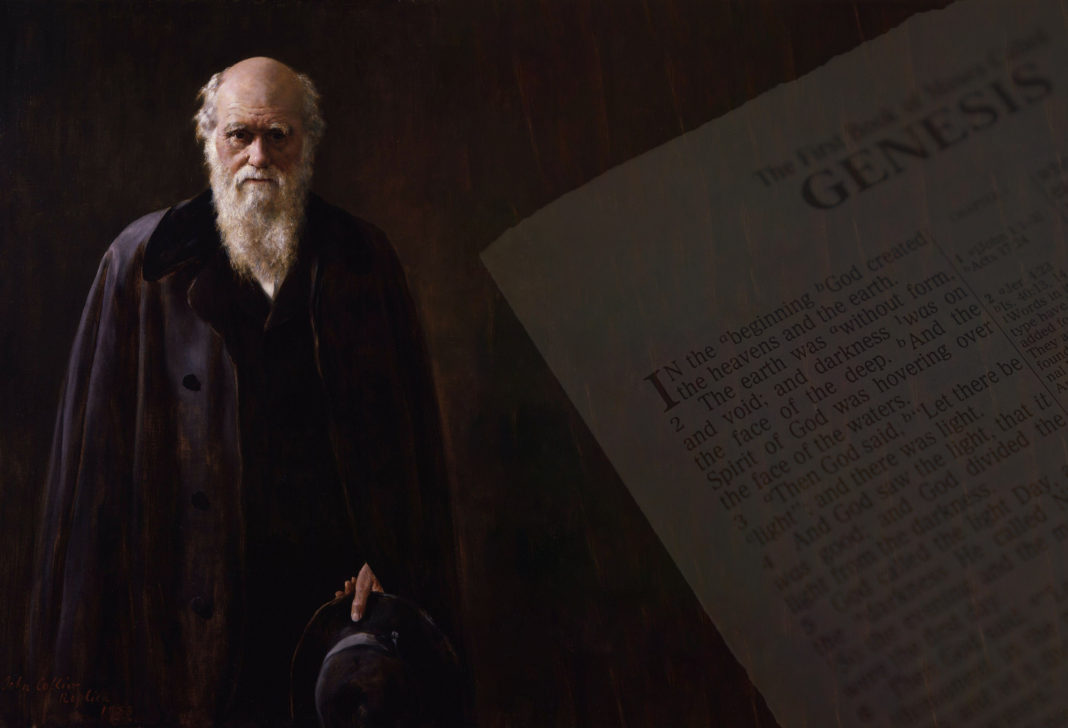Some time ago I came across a study about the growing number of Christian denominations that had accepted the theory of evolution either in whole or in part. And while I don’t remember where exactly I came across the information, what I do remember is the state of absolute disbelief it left me in. My consternation notwithstanding, I have since come to realize that as alarming as this trend towards embracing evolution in the church might be, it is actually only one piece of a much larger picture that will require bigger questions and an even bigger worldview to take it all in. Constructing that bigger picture will very likely make for lengthier article than normal, but I hope you’ll continue to the end because what follows has completely turned my understanding of this issue upside down, given me a renewed hope, and very high expectations for the future of the church. I hope that it will do the same for you!
One of the most helpful studies on the subject I’ve come across is a 2009 Pew research survey which examined the following list of Christian denominations which have all publicly accepted some form of the theory of evolution as true. It included
- The Catholic Church
- The United Methodists
- The Presbyterian Church
- The Episcopalian Church
- Evangelical Lutherans, and
- The United Church of Christ
I’ve also discovered that in addition to that list, you can essentially add all sects of American Judaism, including the Reconstructionist, Reform, Conservative and Orthodox branches, along with all the major forms of Judaism found outside the US, all of which generally find no internal conflict in accepting evolution as truth. And on top of that we can even throw in the Mormon church who, though it hasn’t taken an official stance on the issue, has had several high-ranking officials suggest that evolution “does not directly contradict their church teachings.”
Churches Standing Firm
On the other side of this issue the two denominations that have taken the strongest stance against evolution have been The Southern Baptist Convention and The Seventh Day Adventist Church.
These two church groups comprise a major center of dissent in the United States, steadfastly holding to a literal understanding of the Genesis account, that God created the Earth, and the universe it resides in, in 6 literal days. This is significant because as churches that embraced evolution have moved in increasingly liberal directions over the last several decades they have also at the same time seen their membership numbers cut nearly in half. While incredibly, over that same period, the Southern Baptists and Seventh Day Adventists both saw their membership numbers nearly doubled in size.
In the Book “What’s So Great About Christianity” the author provides the following astonishing numbers.
From 1960 to roughly 2008
- The Presbyterian church had 4.2 million members; it now has 2.4 million.
- The Episcopal church had 3.4 million; it now has 2.3 million.
- The United Church of Christ had 2.2 million; and it now has only 1.3 million.
But In that same period of time…
- The Southern Baptist Convention grew from 8.7 million members to 16.4 million
- The Seventh Day Adventist Church Grew from 1.2 million members to an astonishing near 16 million!
As incredible as those numbers are, the current decade is proving to be a much more challenging one. And denominations such as the Baptists and Adventists, which have thrived over the last 5 decades while maintaining their young earth creationist worldview, are also quickly discovering that they will not be exempt from having to meet the new challenges of an increasingly secularized society.
A more recent 2014 Pew Research Study gives evidence how these new challenges are beginning to unfold. It found that while the Adventist Church continued to grow rapidly over the current decade worldwide, in the United States its growth rate fell to just a fraction of a percent. The Southern Baptists on the other hand have experienced 9 straight years of decline as of 2016, which amounts to about a 1% decline per year. But when these numbers are compared with the respective 3% and 6% declines in membership for the Presbyterian and Episcopalian denominations, that 1% turns out to be quite moderate. This is particularly so when one considers the result of another study which found that when Southern Baptists do leave the church it is most often to join another Christian denomination. Even with these small upsides for Baptists and Adventists however, the data for the current decade doesn’t look like its trending in a positive direction. Has the ground shifted beneath our feet? Is this the new normal?
The New Normal?
The numbers are particularly important because they highlight the challenges churches are beginning to face as they seek to complete the great commission in societies that seem increasingly hostile to the message they bring. In part, the move from disinterest towards open hostility in some communities seems to have grown out of the work of a small group of scientists and journalists who are collectively known as “The New Atheists”. This group includes individuals such as Sam Harris, Richard Dawkins, Daniel Dennett, and Christopher Hitchens. Together they have authored books with titles such as
- The End of Faith
- The God Delusion
- God is Not Great, and
- Breaking the Spell of Religion
“In the last five years alone, the [religiously] unaffiliated have increased from just over 15% to just under 20% of all U.S. adults.
And a study reported in National Geographic that found that by 2016
The number of religiously unaffiliated, also called “nones”, has risen by another 5% now accounting for 25% of the US adult population.
it’s clear that finding the positive outcomes is going to require a bigger picture. To develop that bigger picture we will need put the studies we’ve looked at so far into the greater context of the global trends in Christianity. Together with new research that is adding some interesting refinements to our understanding of these trends we will be able to develop a much clearer picture of what this all means. And the results may surprise you.
The Greater Context
Let me preface this section by pointing out that the “rise in nones” isn’t necessarily a “rise in nones”. What I mean by this is that thanks to the work of the “New Atheists” an environment has been created where those who were already leaning towards atheism or loosely holding on to some form of “cultural Christianity” were free disassociate themselves with little to no social repercussions. And this has been a very good thing! It essentially means that those who claim to identify as Christian in current and future surveys are actually more likely to be practicing Christians. Further it also means that the lines between the church and the secular world are much clearer and defined than they have been in a very long time and may provide greater clarity to churches in planning their evangelism efforts and in identifying ineffective or irrelevant messages and programs that can be replaced with discussions and methods that will actually meet seekers where they’re at.
Global Trends
When considering the news of Christianity’s decline in the traditionally Christian nations of Europe, the United States, and Canada it is extremely important to realize that all the nations of Europe, the United States, and Canada combined only account for about 1.1 billion, or 15%, of the Earth’s total population of over 7.4 billion. This is important because in the other 85% of the world Christianity is on the ascendancy, rather than in decline, experiencing massive growth on almost every corner of the globe! For example, the number of Christians in Africa and Latin America alone now more than exceeds the total population of the United States, Canada, and Europe combined.
And as The Washington Post reported last year the growth of Christianity in Asia is occurring at twice the rate of population growth.
“Asia is also experiencing growth as world Christianity’s center has moved not only South, but also East. In the last century, Christianity grew at twice the rate of the population in that continent. Asia’s Christian population of 350 million is projected to grow to 460 million by 2025… [And] the global religious wildcard is China. Even today, demographers estimate that more Christian believers are found worshipping in China on any given Sunday than in the United States. Future trends, while difficult to predict because so much is below the religious radar, could dramatically drive down the world’s religious “nones.”
Why is this explosive growth in Christianity in the rest of the world so important to our discussion of Christianity in the west? Glen Sunshine the author of “Why You Think The Way You Do: The Story of Western Worldviews” gives an incredibly simple answer in chapter 11 of that book where he explains the implications of programs such as Social Security found in most European nations as well as in the United States.
“Social Security is set up exactly like a Ponzi scheme, an illegal con game that relies on a constantly expanding base on the bottom to pay off the people on the top… But birthrates have declined sharply. Generation X is less than half the size of the Baby Boomers… So where will the workers come from to shore up Social Security and Medicare? From immigration, illegal or not…“
And where will these immigrants come from? Overwhelmingly they are coming from the very nations where Christianity is experience it’s most rapid growth. And interestingly they are bringing with them their belief in a literal 6 day creation and a young earth. As societies begin to increasingly reflect the growing number of minority and immigrant families whose Christianity more closely resembles that of America’s past it they may very well end up bringing it back to the future. So while the current decline in numbers represents real challenges for evangelism in places like the United States, the bigger picture should make it clear that this is not the new normal. If any group is facing a crisis of existence it appears to be atheism, but the data is clear, it certainly isn’t Christianity.
Recent Research
Finally getting back to where we started this discussion, the rates of loss among denominations that have openly embraced evolution. The one major denomination for which I didn’t give explicit numbers in this regard was the Catholic church, and for good reason. More than any other denomination in Christianity it is the Catholic church that has been foremost in its attempts to embrace secular science.
The strongest evidence of this is perhaps found in a 1996 address to the Pontifical Academy of Sciences, given by Pope John Paul II in which he updated the Church’s position to fully and openly accepting the theory of evolution as “more than a hypothesis”.
… new findings lead us toward the recognition of evolution as more than a hypothesis. In fact it is remarkable that this theory has had progressively greater influence on the spirit of researchers, following a series of discoveries in different scholarly disciplines. The convergence in the results of these independent studies—which was neither planned nor sought—constitutes in itself a significant argument in favor of the theory.
Extraordinarily, in 2009 the Vatican also hosted a five day conference on astrobiology, which is to say extraterrestrial life, that attracted dozens of the world’s top astronomers, physicists, cosmologists, and biologists from around the world. The Vatican has made it clear, if contact is to made with extra-terrestrials they want a shot at being first. In support of this goal it has dedicated two full time Jesuit astronomers, established a Vatican-owned observatory in Arizona, and in a move that has sparked dozen of conspiracy theories, they are even making use of the very powerful LUCIFER telescope (Yep, That’s really it’s name) on nearby Mount Graham, all in an attempt to be first.
All these interesting facts aside however, what’s most interesting, and more relevant to our discussion, is the fact that there seems to be a curious correlation in the degree to which a denomination embraces evolution and the rate at which it is losing adherents. In fact the recent data I alluded to earlier seems to indicate that in America the increased number of “nones”, the newly religiously unaffiliated, are disproportionately coming out of the Catholic church and at a rate of 2 to 5 times that of some Protestant churches.
“While non-white Protestant.. religious groups have remained fairly stable, white Protestants and Catholics have all experienced declines, with Catholics suffering the largest decline among all major religious groups: a 10-percentage point loss overall. Nearly one-third (31%) of Americans report being raised in a Catholic household, but only about one in five (21%) Americans identify as Catholic currently… White evangelical Protestants and white mainline Protestants are also witnessing negative growth, but to a much more modest degree (-2 percentage points and -5 percentage points, respectively).”
Full Report: Public Religion Research Institute, Washington D.C., September 2016
In light of this new data from the P.R.R.I. many are rethinking the numbers and their implications, including Patricia Miller, a journalist and Catholic who recently penned an article for the USC Annenberg School’s online magazine “Religious Dispatches” is titled:
“IS THE RISE OF “NONES” ACTUALLY THE DECLINE OF CATHOLICS?”
The Bigger Picture
The implications I believe are clear… When Christian churches choose consistency with secular society over consistency with God’s word, it is a choice made at their own peril.
I have tried to make the case for hope and to establish good reasons for choosing the clear word of scripture over the current state of secular thought, but I do so realizing that the surety of Christianity’s continued relevance in the world in no way implies that the road ahead will be smooth. In fact the road ahead must look remarkably similar to the one Christians in the early days of the church faced after Roman Emperors had embraced Christianity and declared it the sole state religion of the empire in 380 A.D. In those days Christianity was carried by the empire and supported by the culture. But Those days gave way to a new reality when Pagan Barbarian tribe began to conquer and parcel out the empire piece by piece. The outlook for the church must have seemed as bleak then as some believe it today. But the incredible testimony of history is that it was only after losing it’s state supported place of dominance in society when Christianity and had to really rethink its message, its mission, and how it would relate to this new reality, that the faith spread fastest. It was in fact only after the collapse Rome that it could be said that Christianity had won the whole of Europe. I believe that as the once Christian nations of the west give way to the rising tide of secularism as Rome gave way to the pagan cultures that conquered it we find a pattern for hope in the future. Because the bigger picture now just as then is this, Paraphrasing Dinesh D’Souza, Christianity is winning, secularism is losing, and while the future is yet unknown, one trend is clear. God is the future, and atheism is on its way out!











